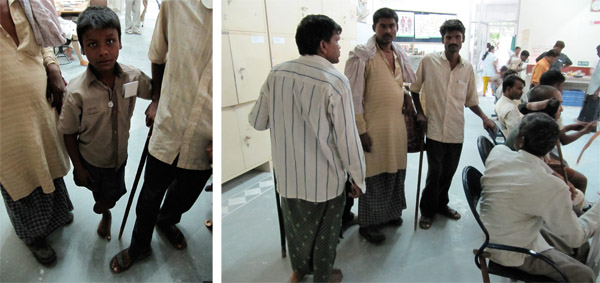Jaipur Foot Organisation
August 28th, 2009Tags: bmvss, developing world, india, jaipur foot, jaipur foot organisation, lower limb, prosthetics, rapid prototyping
I visited the Jaipur Foot Organisation in Rajasthan, India with Kenny Cheung in August 2009

The foot manufacturing process is swift, with each worker making between 4 and 6 feet daily.
The Jaipur Foot organisation produces the most low cost lower limb prosthetics in the world, fitting around 200 patients a day with above the knee or below the knee limbs. Their famous Jaipur foot is made of closed cell microfoam and rubber, hand carved and moulded in house. Together with the fitted leg and knee, each limb comes out to about 30 dollars in cost. They might not be the most high tech of limbs, but they are helping hundreds of amputees around the world each day.

The rubber rolling process
Besides making the prostheses in house, they make many of the materials they need in house too. They roll their own rubber (which they can tint themselves depending on the colour they think is most like the patients they will be having that week), recycle their own plaster for casting, build their own tools.

Not all of the legs turn out, and there is still a reasonable amount of waste from the process.
The shafts of the legs are made from high density polyethylene, a thermoplast they bake in large German-made precision ovens and then fit around the plaster of paris mould they have taken of the leg stump. The workers who do this are part trained medical staff and part untrained workers who have built up years of skill in the fitting of prosthetics.
There are two kinds of knee joints that Jaipur foot fits: endoskeletal and exoskeletal. The exoskeletal joints can sometimes be locked into place because if the patient would be standing for a long time, it might be easier to lock the leg into the standing position instead of risking the leg suddenly giving way.
The endoskeletal knee that Jaipur foot is now providing was designed by a group of Stanford students in ME382: Biomedical Device Design, taught by Mechanical Engineering Professor Tom Andriacchi. (Although there is some speculation about the originality of their research). It is a cnc-routed poly-propelene knee which is load bearing in the standing position but will swing with the weight of the foot while walking.
The Stanford knee in testing
Some fifteen percent of the patients that come to Jaipur Foot have what the doctors call and “unfittable stump”. Most of the people in India who lose limbs lose them to trauma, unlike in the US where most limbs are lost to diabetes. In the emergency situations of trauma cases, sometimes there is no amputation doctor available, and doctors will just try to save as much of a limb as possible. This can however result in a stump very unsuited for fitting with a prosthetic.

About ten percent of the patients are children, who have special needs for their prosthetics because they are still growing and might not be able to use a normal prosthetic for very long before adjustment.
In cases like these, Jaipur Foot offers other things to help the patients, for instance, they make their own hand-powered tricycles, with racks on the back which the patient can use to transport their belongings or set up a market stall with. Jaipur Foot will also give patients sewing machines or other objects to jumpstart a new career for the patients.

All the tricycles are painted bright yellow, and are really quite lovely objects.
I was visiting instead of Neil Gershenfeld, to see if Jaipur Foot would be interested in developing a Fablab-style research branch for rapid prototyping of prosthetics. One thing is setting up a research facility though, and the other is having people with time to do the research. The doctors I spoke to were all very keen, but simultaneously did not seem to have much time to spend making prototypes or an inclination to work with machining. It all left a big impression on me though, I hope I can work with them in the future.
